The Clapham Society Local History Series — 5
Clapham Deep Shelters
by Derrick Johnson and Alyson Wilson
A talk given at the Clapham Society’s meeting on 17 September 2008
Update July 2018 – More has been discovered and achieved since this talk was published (2008)
Read about the BBC article in our News.
Part I — Derrick Johnson
The Construction and wartime use of the deep shelters
With the rise to power of Adolf Hitler in 1933 and the resulting rearmament of Germany there was a gradual realisation that war was inevitable and in 1937 the Government passed the Air Raid Precautions (ARP) Act which compelled local authorities to prepare plans for the protection of citizens in the event of attacks from the air. Most authorities responded to this by providing gas masks and domestic shelters such as the Anderson shelter with which some of you will be all too familiar. However, there was some agitation, notably from Communists and other left-wing sympathisers, for a more elaborate system of deep shelters. This was partly as a result of their experience of aerial bombardment during the Spanish Civil War when the tunnels below the streets of Barcelona had provided good protection.
The Government was unenthusiastic — partly on the grounds of cost and also in the belief that people might stay in the shelters when the raids had ceased. It was reluctant even to allow shelterers to use the existing underground railway stations. However, during the blitz bombing of London on 8 September 1940 a large crowd broke through the locked gates at Liverpool Street Station and took refuge on the platforms. The next day the Minister for Home Security solemnly announced that the Government had reconsidered the matter of the tubes being used as shelters.
The Ministry now commissioned a report from engineers on the options available for deep shelters and consulted with the London Passenger Transport Board, later to become London Transport. The eventual decision was to build the deep shelters beneath the train running tunnels and linked to existing underground stations. The idea, never realised, was that the deep shelter tunnels could be joined up after the war to provide a new express tube parallel to the Northern Line. An ingenious scheme by London Transport to get part of the line built at Government expense.
The illustrations: Please click on thumbnail or text link to see a larger version.
We regret that for copyright reasons we are unable to show thumbnails for all pictures.
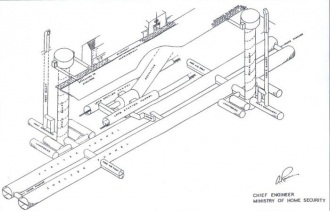
Here is a drawing of a deep shelter beneath an existing tube station. There are two train running tunnels with the escalator to the surface. Beneath these and parallel to them are the shelter tunnels themselves with cross passages. At either end are the ventilation shafts and the stair shafts from which arise the very recognisable shaft head portals, which will be familiar to you all, above the surface.
Things were now moving quickly and on 20 November 1940 London Transport set out firm plans. There would be five sites south of the river — at Clapham South, Clapham Common, Clapham North, Stockwell and Oval — and five to the north. The shelters would have twin parallel tunnels 16’6″ (5 m) in diameter and 400 yards (366 m) long divided into two decks that would accommodate 9600 people in bunks. This figure was later reduced to 8000 in order to provide better living standards. Access would be primarily by stairs rather than lifts as studies showed that 8000 people per hour could negotiate stairs whereas lifts could only carry 1000 in the same period. Because of the need for speed, hand tunnelling rather than the use of shields was the only viable option. To gain experience of laying and fitting out the tunnels London Transport erected on Clapham Common a full scale model of a section of tube complete with bunks and ventilation. One of the problems was what to do with the enormous amounts of spoil removed — estimated at 200,000 cubic yards (153,000 cubic metres) south of the river. London Transport negotiated the purchase of 130 second-hand lorries at £425 — £500 each to carry it away. The London County Council gave permission for 125,000 cubic yards (96,000 cubic metres) to be dumped on Clapham Common and the height of this dump rose to 20 feet (6 metres). A site in Nightingale Lane was identified for the deposit of 20,000 cubic yards (15,300 cubic metres) and this was close enough to allow a gantry for spoil transfer. A further 20,000 cubic yards (15,300 cubic metres) were similarly dumped at Clapham North on the site of three bomb damaged houses in Clapham Road after allotment holders there had been given £5 each to relocate. 1671 cast iron tunnel segments were shipped from Middlesborough to Clapham Common and this 1941 picture shows some of them in place.
Fig. 2
Building the shelters
www.gettyimages.ie/image/3313805.
On 21 October 1942 Clapham South and Clapham North deep shelters were fitted out and were handed over, with Clapham Common ready by the end of the month. London Transport’s original view that the total cost of all the shelters would not be less than £1.5 million was correct. It was later calculated that the eight completed shelters and the abandoned Oval shaft had cost over £3 million by 1942 — over twice the original estimate.
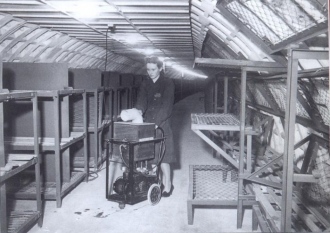
So, what was it like inside a deep shelter up to 300 ft ( 91 m) below ground? This photograph taken in September 1942 shows Clapham South nearing completion with its three layers of bunks — the mobile apparatus is described as an air purifier.
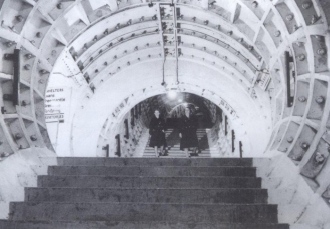
Here is an entrance staircase, painted white with unshaded lighting and two of the volunteer wardens.

And here is the welcoming committee in a rather more reassuring view. It was realised that because of the size and similarity of the shelters people might become disorientated and have difficulty in finding a particular spot. The staircases were therefore colour coded, red or blue, and each of the 16 sections in a shelter was given a name starting with a different letter of the alphabet. Patriotically Clapham South was given the names of British naval commanders starting with Anson and proceeding via Beatty, Collingwood and Drake to Parry. Clapham Common was named after engineers whilst Clapham North was more artistic with writers from Arnold to Wordsworth.
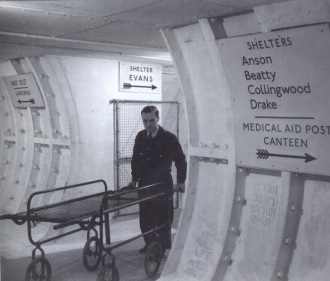
You can see some of the names in this picture in the distinctive London Transport Johnston lettering. The man wheeling the stretcher is wearing a standard civil defence ARP boiler suit.
Another matter which had to be addressed was that of food and drink. The Ministry of Food concluded that if the deep shelters were to be given over to the general public then light refreshments would be sufficient. Canteens were provided with cakes and sandwiches prepared by London Transport and delivered by trains called ‘refreshment specials’. The price of tea was a contentious issue. There was a complaint to the Minister of Home Security when a cup served by the voluntary helpers was increased from 1d (0.4p) to 2d (0.8p) to conform with the price charged by London Transport, who had to pay their staff
Day to day operations of the eight shelters were administered by a Mr Copeman, who was based at a compound next to the south entrance of the Clapham South shelter. He had joined the International Brigade at the outbreak of the Spanish Civil War, had been wounded and elected to the Executive Committee of the Communist Party. Disillusioned, he worked closely with Herbert Morrison and was awarded the OBE in 1945. He subsequently worked as a foreman for the Ford Motor Company at Dagenham. Tickets were printed at Clapham South and distributed to the various boroughs. They were to be issued to people without adequate shelter, especially those who had recently lost their homes.

Here we see shelterers making up their bunks for the night. Although the first complete shelter was ready for occupation in March 1942, and the others were finished later that year there had been a fall off in bombing raids on the capital and the Ministry of Home Security was reluctant to bring them into use. Goodge Street shelter was made available to General Eisenhower’s staff towards the end of 1942 and Chancery Lane was used for billeting troops. It was eventually realised that the exercise would be a good way of getting practical experience of shelter management, and Stockwell was opened to soldiers in January 1943. National Fire service personnel were allowed to benefit, with men allowed into Clapham North and women into Goodge Street — well separated you will note — in May 1943. Later that year Stockwell was converted into a hostel for American troops and sections of Clapham North and Clapham South were used to billet British servicemen on leave. These military uses were maintained despite agitation that the shelters should be used for their proper purpose.
It was not until the arrival of the VI rockets from 13 June 1944, and the even more powerful V2s from 8 September that a decision was taken to open the deep shelters to the public. Stockwell, Clapham North and Clapham South all opened in July 1944.
Fig. 8
Shelter shaft head at Clapham South
www.gettyimages.ie/image/79655735
This picture was taken at that time. You will note the flower shop (Dover) still bears the same name today. The ventilation outlets have since been removed.
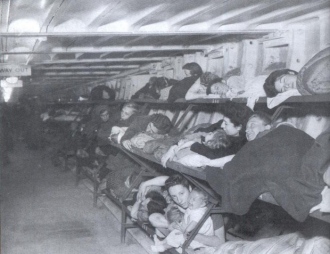
There was a full house at Clapham South when this picture was taken in July 1944. However, three months later numbers sleeping underground had declined to such an extent that some shelters could be closed. Final closure of the deep shelters took place on 7 May 1945 and shelters in the tube stations closed at the same time.

In considering whether the construction of the deep shelters was justified, we must remember that they were built in reaction to a threat and not in anticipation of it. Had they been ready before the war began they would have been valuable during the Blitz. It was only during the, mercifully short, period of the V1 and V2 rocket attacks that they came into their own. Even then, the highest recorded population, on 24 July 1944 was only 12,297 — about 33% of their total nightly capacity.
From final planning stage to being ready for use took less than two years — quite impressive bearing in mind that they were dug by hand. They fulfilled their purpose in providing secure accommodation from air raids and, apart from a fire at Goodge Street in 1956, they have served a number of other purposes since, without incident or failure.
Today the only signs of the existence of the deep shelters are the twin shaft heads, looking like giant public conveniences, and in a greater or lesser state of dereliction. No attempt was made to blend them into their surroundings but the architectural merit of the Balham Hill shaft at Clapham South has been recognised in the Grade II listing accorded to it.
Post—war uses
So, what happened to the deep shelters after the last wartime shelterer left in May 1945? Clapham North was used for document storage by the Board of Trade and the Public Record Office until August 1951, and as a billet for naval personnel on duty during the Coronation in 1953. Clapham Common was used by the Admiralty and the Principal Probate Office for document storage from July 1945 until 1951 and closed entirely on 3 October 1952. It was then leased to various private data management companies. Clapham South was used by the War Office as troop billets in June 1946, as hotel accommodation for the Festival of Britain in 1951, as a billet for troops lining the route for the funeral of George V1 in 1952 and for Coronation visitors in 1953. However, it was its use in 1948 that, as we shall hear, had a profound effect on the population of South London.
Part II — Alyson Wilson
Arrival of MV Empire Windrush from Jamaica in 1948

The most well-known use of the deep shelter at Clapham South is, undoubtedly, as the temporary home for the first immigrants from the Caribbean who arrived on MV Empire Windrush in June 1948.
The Empire Windrush was a former German troop ship which had been seized by the British at the end of the war, refitted as a British troop ship and renamed in 1947. En route from Australia to England via the Atlantic the ship docked at Kingston, Jamaica in May 1948. An advertisement had appeared in Jamaica’s Daily Gleaner on 13 April offering transport to the UK, for a fare of £28.10s (£28.50), for anyone who wanted to come to work in the UK. Many of those who took up the offer were ex—RAF servicemen, who already knew England and hoped to rejoin the services. Typical of these was Sam King who had been a Leading Aircraftman in the RAF, stationed in Britain. When he was demobbed in 1947 and returned to Jamaica the economy was suffering from a recent hurricane that had destroyed most of the banana, coconut and coffee crops, and he could not find a job. His family, who farmed a small piece of land, sold three cows to raise the money for his fare. Others simply wanted to try their luck in what they regarded as ‘the mother country’ reports of which had come back to them from those who had served in the UK during the war. These men had received a good traditional British education and were generally well informed about British history. Many had qualifications of some sort. There were strict controls on who was allowed to come at this time. Sam King wrote: ‘To get papers to leave, a Justice of the Peace had to sign to say you were a responsible citizen and the police had to sign to say you were not a trouble maker.’
And so they set out on their journey, arriving at Tilbury on 22 June, 1948. The next day the Daily Mirror reported their arrival: (clearly somewhat surprised by their appearance):
‘Some of the 492 Jamaican emigrants who arrived in Britain yesterday in the Empire Windrush wore expensive suits. There were even emigrants wearing zoot-style suits — very long-waisted jacket, big padded shoulders, slit pockets and peg-top trousers — costing 15 to 28 pounds. There were flash ties (from 10s 6d [52.5p] to one pound 1s [£1.05p]) and white-and-tan shoes. (75s) [£3.75p] . The explanation was given last night by one quietly dressed Jamaican, Oswald Denniston, 35, sign-painter. Mr Denniston told me: “Most of us are job-seekers but others are here to finish their trades and education. The very poor can’t leave Jamaica. They must have 28 pounds for their passage and another five pounds when they sail.”‘
About half of those who arrived on that day already had contacts in the country and somewhere to go and live, but it was those who had nowhere to go who were bussed from Tilbury to Clapham and housed in the deep shelter at Clapham South. Several reports tell what a surprise the endless streets of shabby run-down terraced houses were to these new arrivals from the Caribbean. Even on an English June day they were a strong contrast to the West Indian sunshine and light the immigrants were used to.
Fig. 12
Reception tent at entrance to the shelter
www.gettyimages.ie/image/3094600
On arrival at Clapham they found a reception tent at the top of the entrance shaft to the shelter. They lined up to check in there and each man was given a coarse white linen sheet and a grey blanket, and allocated a bunk. They then descended in the rickety lift into what one immigrant described as ‘the bowels of South London’, where he said: ‘They curiously eyed the network of poorly lit, clammy, musty tunnels that had been offered to them as residence. It was primitive and unwelcoming, like a sparsely furnished rabbit’s warren. But in a strange new land, there were few alternatives’.
Fig. 13
Unpacking in the deep shelter
www.gettyimages.ie/image/3362542
Here we see the men unpacking their belongings and settling in to their temporary accommodation.
Fig. 14
Cramped quarters for dressing
www.gettyimages.ie/image/3426892
Fig. 15
Lining up in the canteen tent
www.gettyimages.ie/image/3312156
The Women’s Voluntary Service provided refreshments in the tent on Clapham Common at the head of the entrance shaft. One of the immigrants wrote that he was ‘served with a cheery cup of traditional English tea and coarse white bread with dripping’ and warned to be grateful since post-war Britain still had strict rationing, and it was not easy to find food. The Daily Express reported: ‘All of them sat down to their first meal on English soil: roast beef, potatoes, vegetables, Yorkshire pudding, suet pudding with currants and custard.’ The report continued ‘…a bed and three hot meals cost them 6s.6d. (33p) a day. Most of the Jamaicans have about £5 to last them until they find work.’
Fig. 16
A meal in the canteen tent
www.gettyimages.ie/image/3066592
Fig. 17
Relaxing underground
www.gettyimages.ie/image/3362203
Some men obviously relaxed down in the shelters as this man here reading the paper — is he looking for a job or for accommodation?
Fig. 18
Sitting about above ground
www.gettyimages.ie/image/3334311
.. but not surprisingly many preferred to relax on the Common rather than underground.
One of the first men to get a job was Mr Denniston, quoted above, who was employed on the site at £4 per week where a newspaper reported: ‘Wrapped in two blankets to keep warm, he settled in as night watchman of the meals marquee in Clapham Common, SW, where 240 of the Jamaicans are staying in deep wartime shelters.’To find work most of the immigrants went to the nearest Labour Exchange (Job Centre) which was in Coldharbour Lane, Brixton. Many found jobs in the National Health Service, some worked in factories and mills locally but by far the largest employer was London Transport. Sam King recorded that within three weeks each person had a job. Another immigrant wrote that none of them stayed long in the shelters. He said most were there only a few days, and he stayed about two weeks.
Gradually the immigrants moved on to rented houses and rooms, mostly in the Brixton and Clapham areas. As time went on those who had already settled were more ready to take in their compatriots than some local landlords. There are stories of great problems in finding accommodation, signs saying ‘No blacks’ (also ‘No Dogs’ and ‘No Irish’) and plenty of advertisements offering accommodation, which mysteriously turned out to have been taken already when an immigrant arrived. Some were reluctant to rent property, because they did not wish to be beholden to anyone and they clubbed together to purchase houses, often in family groups.
The actual time the shelters were occupied by the immigrants from the Caribbean was relatively short, but the impact of their arrival on the area was dramatic and long-lasting — the origins of the multi-racial community in South London. Some of the early immigrants made a lasting impact individually. Sam King, whom I quoted earlier, went on to become a prominent member of the South London black community. He was a Southwark councillor, mayor of Southwark, a leader of the Pentecostal Church and he was awarded the MBE. He has written about his experiences quite extensively and described the Empire Windrush as ‘a little Mayflower’, adding ‘Immigration to this country really started with that boat’.
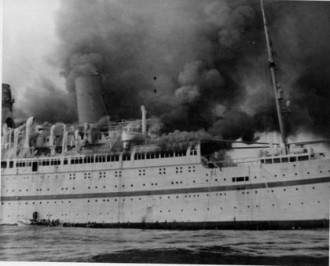
What happened to the Windrush afterwards? Well, in March 1954 she was bringing troops back from the Korean War when, with 1700 men, women and children on board, she caught fire and sank dramatically in the Mediterranean. All except four crew members were saved in what is remembered as one of the greatest rescues in maritime history.
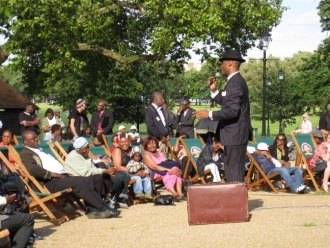
This summer in Clapham we had our own celebration of the 60th anniversary of the arrival of the Empire Windrush with the first immigrants from the West Indies. An appropriately dressed singer, even carrying the correct period suitcase, entertained a large multi-racial crowd by the Bandstand on Clapham Common.
Part III
Recordings of memories of three people who actually experienced using the deep shelters were then played. Transcriptions follow:
(1) Margaret Barford and her family lived in the deep shelter at Clapham South for two years after their home had been destroyed by a VI. We are grateful to Anne Isherwood and Janet Dickinson for arranging the interview and recording.
‘I was born in a nursing home in Nightingale Lane, Clapham South and lived in Balham with my parents and grandmother. I was six years old when the war started, and living in the road adjacent to the old St James’ Hospital and the railway line at Wandsworth Common, which made us a target for bombing when it started. We had our cellar reinforced and a Morrison table shelter installed in the dining room and survived the Blitz when it started, fairly well. Then the VIs or doodlebugs as they were known started and everything changed. When I was nine years old, I think, a daytime doodlebug came over, and the engine cut out and it crashed on about five houses in a row in our road. I was at school, my father at work. My mother, grandmother and uncle who were in the cellar were safely dug out and rescued. I came home from school to find the shell of our house leaning over and most of our belongings destroyed. We moved to my uncle’s house, also in Balham, but two weeks later the same thing happened there, so we then had two families homeless.
My father was advised that if we went and explained our position at the local town hall we might be eligible for places to sleep in the deep shelters. There were three of these in South London and until now very little was known about them. Rumours abounded that they had been built to house troops in the event of an invasion, but whether this was true was never confirmed. We only knew they were deep beneath the underground, and that was all.
As we were homeless our two families were allocated passes and told the conditions of using them, and so about a year of this type of living began. We were allowed to go down to the shelter from 6 pm onwards and had to come up by 7 am next morning. My father managed to find two rooms for us to use during the day. I was sent to school, he was at work and mother and grandmother stayed in the rooms all day. Then after tea we began the trek to the shelter. We were allowed to leave bedding on our allocated bunks but nothing else, so personal things were packed and unpacked daily. We caught the bus to Clapham South station, used our passes to go down on the escalator to underground level and then through a door we had never noticed before in the corner, and down spiral stairs to the shelter. These stairs wound round a small lift which the elderly and disabled could use by having a special pass allocated to them. I cannot remember how many stairs there were but it was a great many, and these all had to be climbed again in the morning.
Once down, we made our way to our allocated section of bunks. These sections were named after British admirals. I think ours was Grenville. The steel bunks we had been given were ours to use every day and were positioned in sixes, so a family could be as private as possible. We had two sections for our two families. There was one chair to each six bunks. I slept at the bottom, opposite my grandmother. The floor was concrete and rather cold. There was a tannoy system which relayed news, information and canned music which could be quite annoying for some people after a while. We could not hear anything at all from above ground, although we knew air raids were going on which was quite frightening.
At the head of each section were block toilets and basic washing facilities, rather like a camping site with no real privacy. Also each section had a canteen run by the Red Cross and I particularly remember the jam tarts — a real treat in those days. I don’t know why! These and other edibles and endless cups of tea were on sale and all these canteens were run by volunteers.
Frequently a section would have a concert party to entertain them, which was free, and we thought was great fun. Other sections were invited and it was like a big party. Sometimes there would be dances or sing-songs to keep us occupied and as happy as possible.
Children were eventually persuaded to bed and sleep and the air-conditioners would be turned up full strength and I remember it being very cold during the night. Lights were dimmed but never out, so we were not in the dark. My mother always put me in a nightdress and I went to bed as usual, but I do not think many of the adults undressed fully. They just had shelter clothes.
It was always an early start in the morning which I hated, but we all had to be out by 7 am. We must have looked like a stream of refugees emerging into the daylight. Then back to our own two rooms for breakfast, hoping they were still standing! I presume some type of cleaning took place in the shelters during the day, but I really did not worry much at that age.
Looking back, in my innocence, I loved this type of living. I was an only child which meant I found many friends and raced around the shelter in comparative safety and had a freedom I did not have at home. However, I can remember my mother being very worried. She was never settled until my father was safely home from work. He was a newspaper man, just too old to be called up. She worried about my grandmother who was not in the best of health, and about me as she did not think this was the right way to bring me up. She worried about our constant packing and unpacking every day, whether I had enough sleep, and was concerned about the amount of bomb damage we would find when we came up each morning.
However, we were lucky. We were the privileged ones with passes to comparative safety. We all survived and on the whole were fairly happy and optimistic. I remember the time with affection. I was a child and thought everyone lived like this. I would love the opportunity to go down there again. I often wonder what the shelters are used for now.’
(2) The memory of Clapham resident and Society member, Michael Green, relates to the Goodge Street deep shelter (which was in the North London part of the scheme), where as a young officer doing his National Service he stayed with his men overnight en route to embark at Southampton in 1951.
‘Fifty-seven years ago I was a young officer in the Northamptonshire regiment on National Service, and was stationed at Colchester. During any transit to the ports on the south coast it was necessary to stay in London overnight if an early start was required the following day. We were accommodated in the shelter system under the London Underground, of which that under Goodge Street station brings back certain memories. There was, I recollect, rather a pokey entrance somewhere in the vicinity of the station. Once the necessary documentation had been sorted out at the entrance there was a trip down in an old noisy steel lift which seemed to go on downwards for ever. The accommodation below was off a warren of tunnels with duck-boarded floors. The bedding on the steel bunks was quite comfortable, but my abiding memory was the stuffiness of the atmosphere. There was, of course, a ventilation system of sorts, but no movement of air such as you get in the underground system proper. Another aspect of staying in such a place was a sense of time dislocation. The electric lighting was on 24 hours a day and on waking in the morning it was difficult psychologically to be sure what time of day it might be, without a watch. Prisoners subject in recent times to extreme rendition must have much worse experiences of such time-disorientation.
I do not recollect any arrangements for food, which I must have brought with me from Colchester.
My memories of such an occasion are bound up with one of the more uncomfortable experiences of my young life at the time. I had been ordered to escort a company of infantry from the Colchester barracks to Portsmouth for embarkation to the Far East. My job was to take down all their documentation and see them on to the boat. It was when we were about to board the train at Waterloo that I discovered that although I had all their personal documentation with me I had failed to bring the travel passes — effectively passports — which were sitting back in my room at Colchester. I was worried sick since there was no way I could get back to Colchester and return in time to catch the boat. I remember a porter saying to me as I wandered disconsolately down the platform “Are you alright, mate? You look as if you have just seen a ghost.” Fortunately, the NCOs to the unit had a set of blank forms which I got them to fill in for each of the 50 men, all the way down to Portsmouth. They were not amused. But such were the exigencies of the service for a 20-year old subaltern in 1951.’
At about this time the deep shelter at Clapham South was used as inexpensive hotel accommodation and named the Festival Hotel, which judging by the following report and pictures provided very basic accommodation
Fig. 21
Deep shelter hotel accommodation
www.gettyimages.ie/image/3260557
Fig. 22
The Dining Room
www.gettyimages.ie/image/3260249
Fig. 23
Washing arrangements
www.gettyimages.ie/image/3260556
(3) Finally, we are grateful to Clare Dow for putting us in contact with Bernard Masson, who as a French student visiting England in 1950 and again in 1951 stayed overnight in the deep shelter at Clapham South.
‘In 1950 and 1951 I travelled from Paris to London on my way to the west of England to attend student camps. We needed somewhere to stay, and the address of the deep shelters was given to us by the Concordia organisation, which had sent us to England. There was a hut reception area at the surface level. We just had to turn up, check in, and were issued with a rough sort of hairy, army-type blanket and a pillow and allocated a specific bunk. The cost was about two shillings [10p] or half-a-crown [12½ p] if I remember rightly. It was very, very, very primitive. The bunks were quite stiff, but in fact, we didn’t mind too much because we were all excited to be in a foreign country. The war was just behind us, so we had been in difficult situations and 1951 was the Festival of Britain and it was a great pleasure to see the revival after so many dark years, and seeing for example, the new Festival Hall, the Skylon and even Donald Campbell’s Bluebird. So this was quite exciting.
In 1951 I even came with my bicycle on the ferry from Dieppe to Newhaven and then I just left my bicycle on the Common, where I was told it was quite safe. And I found it the next morning. This is my recollection of these exciting years.’
Part IV — AlysonWilson
A visit to the Deep Shelter at Clapham North in 2006
As we have already heard access to the deep shelters has been very restricted for many years. We always knew that the shelters at Clapham South and Clapham Common have been rented out to private companies for document storage. But we did not know that for some reason the one at Clapham North was still unused in 2006. Through contact with London Transport officials and an underground shelter enthusiast a small group of us were fortunate enough to go down this shelter just before it was let out for the same purpose.A lot of photos were taken, but the conditions were not ideal, so they are not very good. However, you can get an idea of the present condition from just a few pictures. The shelter was really rather unpleasant, musty, airless, with minimal lighting, though it was obviously maintained to a reasonable level.
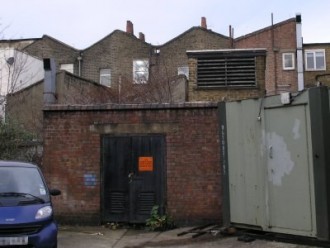
The entrance is extremely unprepossessing!
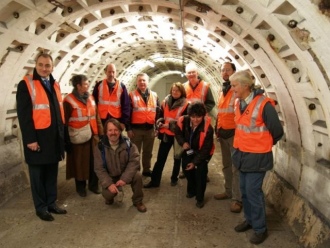
Having found how to actually get inside here is the group appropriately kitted up with fluorescent jackets, but not oddly enough hard hats. You can see the by now familiar structure well in this picture

Many of the original notices survive, including this one at the entrance to the shelter.

Here you can see quite clearly a good length of tunnel, with what appear to be some stored items. Now that it is stripped of its bunks and other furniture one can see how well it matches the descriptions you heard at the beginning of this talk
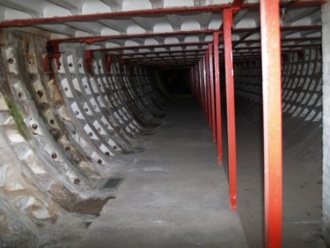
Again this slide shows the curve on the wall and the tunnel shape, and sections which we have seen all along this evening.
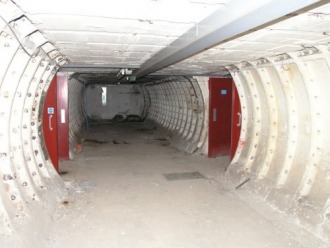
This is one of the main tunnels and on both right and left you can see the big steel doors leading to side chambers, which were washrooms and lavatories.
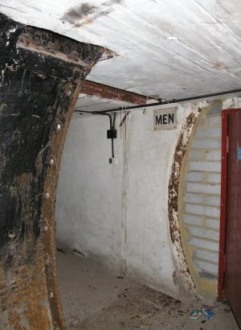
This picture also gives some idea of the rather bad condition of the shelters, with rusting ironwork and general debris lying around. Again original signs still survive.
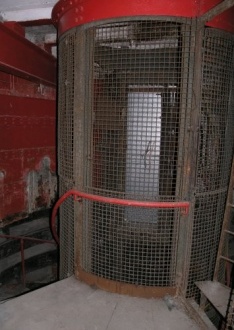
Here is the rather basic lift shaft – the lift is certainly not in operation now and presumably has not been for some time, but you can see alongside it the staircase twisting round it, which was remembered by Mrs Barford in the first recording we heard. It is interesting that she said that even then it was not for general use.
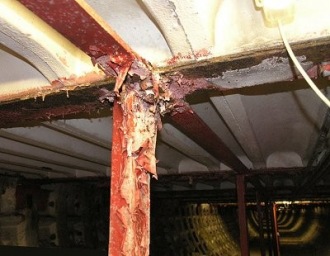
Again another graphic demonstration of the condition of the ironwork, and in the distance you can clearly see the shape of the tunnel.
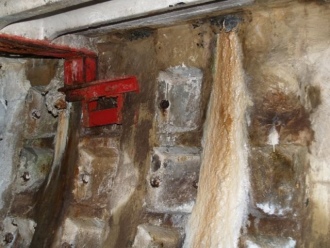
Water has clearly penetrated quite badly here.
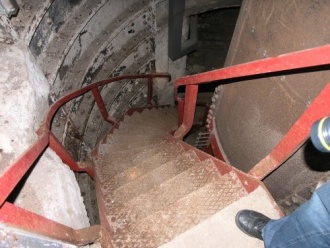
These are the steps alongside the lift shaft again.
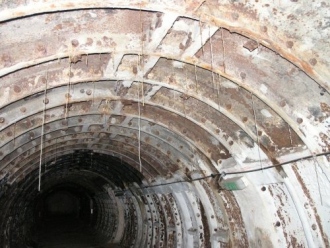
Here you can see what has happened to the roof with water penetrations.
Fig. 36
Stockwell shaft head
www.subbrit.org.uk/sites/stockwell-deep-shelter/
To return to the surface and end on a more cheerful note I show the exterior of one of the tunnel entrances (this is Stockwell) which has been brightly decorated.
There you have the story of the Clapham deep shelters from their conception and building in the early 1940s to their condition today — a story which has always fascinated local people. The curious thing is that local people knew about them when they were being built, but had no idea what they were or why. And the same has always been true. Even today one can hardly fail to notice the unsightly surface constructions near the three Clapham underground stations, but until we started this investigation not many of us knew much about the shelters and their uses.
Bibliography
Clapham Society, Clapham in the Twentieth Century, 2002
Emmerson, Andrew & Beard, Tony, London’s Secret Tubes, 2004
Francis, Viviene, With Hope in their Eyes, 1998
Pennick, Nigel, Bunkers Under London, 1988
Phillips, Mike & Phillips, Trevor, Windrush:The Irresistible Rise of Multi—Racial Britain, 1998
Trench, Richard & Hilman, Ellis, London Under London, 1984
Wicks, Ben, Waiting for the All Clear, 1990
Websites
Subterranea Britannica: www.subbrit.org.uk
The Greater London Industrial Archaelogy Society: www.glias.org.uk
Underground History www.underground-history.co.uk
After the Battle www.afterthebattle.com
Getty Images Ireland www.gettyimages.ie